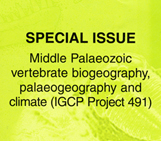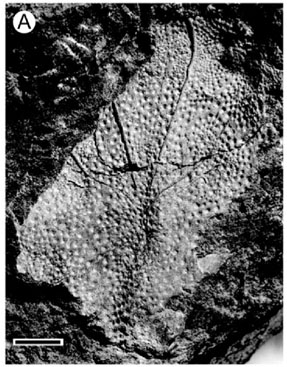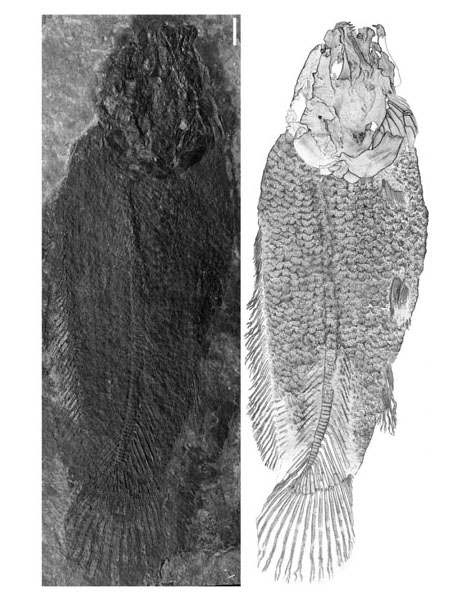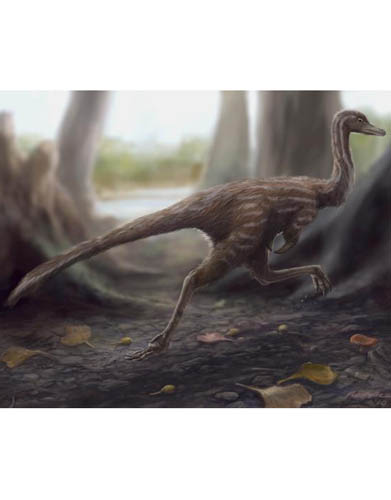|
 Research Progress Research Progress |
|
 |
Special issue of IGCP 491 has published |
The special issue – Middle Palaeozoic vertebrate biogeography: palaeogeography and climate (IGCP 491) has published recently.
The IGCP Project 491 (Middle Palaeozoic vertebrate biogeography: palaeogeography and climate) is under the UNESCO International Geoscience Program, running from 2003 to 2007 with the co-... |
|
|
|
|
|
 |
New Oviraptorid Dinosaur (Theropoda: Oviraptorosauria) Found in China |
| The oviraptorids are a theropod group in which the kull and mandible are highly modified, and are characterized by a short snout, the absence of teeth, a tall mandible, a long parietal, an enlarged tooth-like process on the palate, and a large, anteriorly located external mandiblar fenestra. Ten oviraptorid taxa ha... |
|
 |
New Placoderm Fish Found from the Lower Devonian of Guangxi, China |
| Dr. Min Zhu, Key Laboratory of Evolutionary Systematics of Vertebrates, Institute of Vertebrate Paleontology and Paleoanthropology, Chinese Academy of Sciences, and his collaborators described a new genus and species of the Antarctaspidae (Placodermi: Arthrodira) -Potangaspis parvoculatus, from the early Emsian (Yuk... |
|
 |
New Amiine Fossil Fish Found in China |
| Dr. Meemann Chang, Institute of Vertebrate Paleontology & Paleoanthropology, Chinese Academy of Sciences, and her collaborators, described a new amiine fossil fish, Cyclurus orientalis, from the early to middle Eocene Xiawanpu Formation of Xiawanpu, Xiangxiang city, Hunan Province, China, as reported in the 2nd iss... |
|
 |
Oldest-known black carp found in Mongolian plateau |
| Dr. Pingfu Chen, Institute of Vertebrate Paleontology and Paleoanthropology, Chinese Academy of Sciences, and Dr. Gloria Arratia at the Biodiversity Research Center of the University of Kansas, described an oldest-known black carp, Mylopharyngodon wui, sp. nov., a completely preserved right pharyngeal bone with teet... |
|
 |
Pliocene cyprinids from Kunlun Pass Basin, northeastern Tibetan Plateau |
| Through studying the newly-found cyprinid fish fossils, Drs. Wang Ning and Chang Meemann, Institute of Vertebrate Paleontology and Paleoanthropology, Chinese Academy of Sciences, have shown that the existence of comparatively rich waters in the Kunlun Pass Basin on the southern slope of the East Kunlun Mountain (at ... |
|
 |
Exceptional dinosaur fossils show ontogenetic development of early feathers |
| Dr. Xing Xu, Institute of Vertebrate Paleontology & Paleoanthropology, Chinese Academy of Sciences, and his collaborators, describe an early-juvenile specimen and a late-juvenile specimen, both referable to the oviraptorosaur Similicaudipteryx, recovered from the Lower Cretaceous Yixian Formation of western Liaoning... |
|
 |
First-ever single-claw dinosaur fossil found in China |
| Dr. Xing Xu, Institute of Vertebrate Paleontology and Paleoanthropology (IVPP), Chinese Academy of Sciences, and his collaborators, described a new dinosaur that was one of the smallest known and also one of the best adapted for running.The original paper was published in the scientific journal Zootaxa, 2010 (2413).... |
|
|









